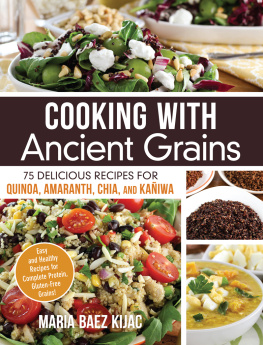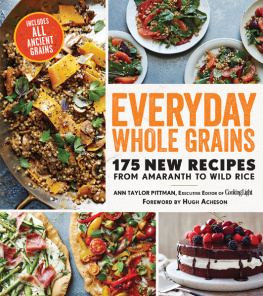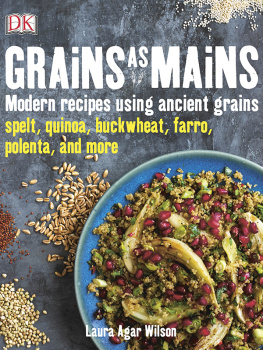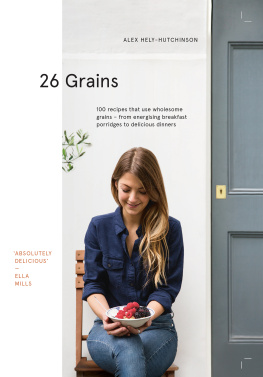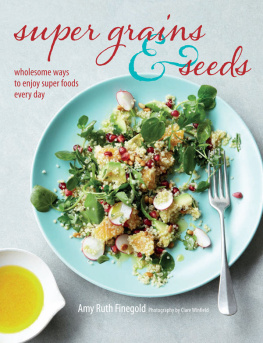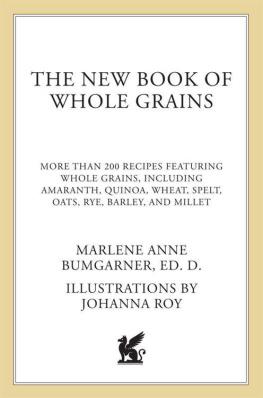Cooking with Ancient Grains
75 Delicious Recipes for Quinoa, Amaranth, Chia, and Kaiwa
MARIA BAEZ KIJAC

Avon, Massachusetts
Contents
Introduction
Quinoa. Amaranth. Kaiwa. Chia.
The indigenous people of the lands that would become known as Latin America revered these grains, which they viewed as a source of life. Because of recent scientific research, we now know that grains, like all seeds, really do contain the essence of life, along with the promise of growth. That is the promise of these grains.
Throughout Cooking with Ancient Grains, youll come to realize that these small seeds hold a large place in the history of our world and contribute some large flavors when used in modern dishes. In , youll find seventy dishes ranging from breakfast to entres to desserts that all highlight the delicious taste and textures of these grains.
I invite you to join mea classically trained cook, teacher, cookbook author, and native of Ecuadorin my kitchen to share with me the joys of preparing the sacred grains of Latin America. In addition to recipes, you will also learn about the tradition of older cultures that, because they considered food to be sacred, prepared it with respect, joy, and love, to the benefit of the spirit and body of the cook and diners alike. I hope you enjoy this journey, which will carry you from the past into the future.
PART 1
Introduction to the Ancient Grains
Before you start cooking, it is useful to know a little more about your ingredients. In this part, you will find information on what the ancient grains are and where they came from, and also why they are important, not just to the health of individuals, but possibly to the health, and even survival, of people around the world. Here, I will also introduce and discuss ideas that are central to understanding the value of these grains and will look at the grains nutritional benefits, provide some information on food issues and sensitivities, explain how to prepare the grains for use in the recipes that follow, and give you some information on other common ingredients that can enable you to expand on or personalize the information that I include here.
CHAPTER 1
History and Preparation of the Ancient Grains
Like life itself, eating habits tend to run in cycles. Trends arise, adding to or replacing old habits. Some trends are temporary fads. However, there are also visible and widespread trends whose evolution is relatively slow but whose impact remains. Ancient grains fall into the trend of the second type, a trend that offers lasting benefits: the trend of returning to natural, satisfying foods. In this chapter, youll learn the history of these ancient grains, some of their benefits, information on gluten, and basic preparation methods needed for some of the recipes in .
THE HISTORY OF THE GRAINS
When Europeans discovered the Americas, they discovered a new world of food as wellmaize/corn (the only true cereal grain of the Americas), potatoes, chilies, tomatoes, chocolate, and other foods. However, while the Spanish Conquistadors eagerly adopted many new foods, they werent interested in what we now call the ancient grainsquinoa, amaranth, kaiwa, and chiabecause they were difficult to grow and harvest and, in some cases, had limited useseven if the locals did value them. Natives of the region that would become Latin America relied on these tiny, nutritious seeds, from which they could make flour and grainlike dishes. However, these seed grains had no gluten, so they couldnt be used to make bread. Europeans wanted bread, and for bread, you need wheat, so thats what the Conquistadors made the locals grow.
But that was not the end of the ancient grains for the indigenous people of Latin America continued to grow and use the tiny seeds the Conquistadors had ignored. Over the last twenty years, more and more research has revealed what these lost foods have to offer. Today, an increasing number of people are trying to find better ways to get wholesome, nutrient-dense food to people who need more or better food. The increasing interest in foods that offer health benefits has led to interest in these grains, even in places where people have enough to eat but might be questioning the quality of the foods they eat. Scientists are now exploring the jungles of Belize and the Amazon, and the slopes of the Andean mountains, looking for little-known plants still cultivated by the natives. Thanks to the efforts of these scientists, the world is beginning to benefit from these once-sacred seedsamaranth, quinoa, kaiwa, and chiaall of which have been shown to possess remarkable nutritional profiles. In fact, scientists, as they work to improve nutrition, are searching the world for environments where these tiny seeds can be grown successfully. Australia has now become the number one producer of chia seeds, and quinoa is now being grown in countries with terrains that are not able to produce other crops.
WHEAT-FREE AND GLUTEN-FREE GRAINS
Quinoa, amaranth, chia, and kaiwa are gluten-free, as is corn. However, this is not the only thing that makes the first four super grains. Unlike cereal grains, quinoa, amaranth, kaiwa, and chia offer complete proteins with a good balance of essential amino acids, giving them a protein profile comparable to whole milk. In addition, chia in particular offers a wide range of nutritional benefits. Of course, for those who have issues with gluten, gluten will be the most important issue. Contrary to popular opinion, problems with wheat and with gluten are not the same thing. Some people who are highly allergic to wheat can consume gluten in other grains. Those who cannot tolerate gluten cannot tolerate it even when its not from wheat. If you are highly allergic to any grain, be careful when trying a new grain. But if your issue is gluten intolerance, these grains offer a way to wonderfully expand your diet.
So what is gluten? It is a protein found in all cereal grains, though it is especially abundant in wheat and its close relatives, barley, and rye. Gluten has a variety of qualities that are important for baked goods and other foods. It helps make dough elastic, provides it with a chewy texture, creates the stretchy network that traps air bubbles and makes bread rise before it is baked, and helps ensure that baked goods maintain their proper shape. Additionally, glutens absorbent quality lets bread soak up gravy. While there is a small amount of gluten in all cereal grains, it varies in composition, and the gluten in corn and rice is safe for celiacs. In fact, rice and corn are generally identified as gluten-free because they do not affect celiacs. (Interestingly, even the rice known as glutinous rice does not have gluten.) However, these are not the only options available. The other gluten-free, wheat-free grains are:
- Amaranth
- Buckwheat
- Chia
- Kaiwa
- Millet
- Quinoa
- Teff (a type of millet grown in Ethiopia)
- Wild rice
Generally, when a product says gluten-free, that means it contains no wheat, barley, or rye, or anything made from these. There are some gluten-free oats, but you have to look specifically for gluten-free oats. Oats are related to rye, barley, and wheat, so depending on your issues with these grains, you may have issues with oats. However, if you want oats and gluten is your only issue, check health food stores for gluten-free varieties.

